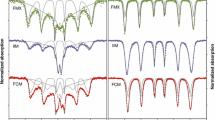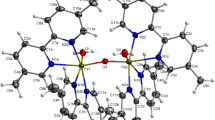Summary
Ferric ions and adriamycin in solution interact to form complexes that can yield colloidal and flocculant mixtures. At high concentrations (Fe3+≥10-4 M, adriamycin ≥10-5 M) an absorption appears at 600 nm, indicating colloid formation, which is directly responsive to concentrations of the reactants. Evidence from dilution experiments by spectral analysis, ultracentrifugation, titration, and filtration indicate that phase transitition that is sensitive to pH and time occurs with iron-adriamycin complexes to yield flocculated drug. We conclude that patients and animals treated with the iron-adriamycin preparations known as ‘quelamycin’ received flocculated iron-adriamycin, which accounts for the toxic and pharmacologic effects reported. It may be useful to utilize colloidal preparations of reactive or irritating drugs to avert acute toxic effects and to produce slower release of active drug.
Similar content being viewed by others
References
Bachur NR, Moore LA, Bernstein JG, Liu A (1970) Tissue distribution and disposition of daunomycin (NSC-82151) in mice: Fluorometric and isotopic methods. Cancer Chemother Rep 54: 89
Basolo F, Johnson RC (1964) Coordination chemistry — the chemistry of metal complexes. Benjamin, New York
Brugarolas A, Pachon N, Gosalvez M, Llanderal AP, Lacave AJ, Buesa JM, Marco MG (1978) Phase I clinical study of quelamycin. Cancer Treat Rep 62: 1527
Calendi E, DiMarco A, Reggiani M, Scarpinato B, Valentini L (1965) On physiocochemical interactions between daunomycin and nucleic acids. Biochim Biophys Acta 103: 25
Egorin MJ, Clawson RE, Ross LA, Friedman RD, Reich SD, Pollack A, Bachur NR (1983) Murine metabolism and disposition of iron: adriamycin complexes. Cancer Res 43: 3253
Gosalvez M, Blanco MF, Vivero C, Valles F (1978) Quelamycin, a new derivative of adriamycin with several possible therapeutic advantages. Eur Cancer 14: 1185
Harvey AE Jr, Smart JA, Amis ES (1955) Simultaneous spectrophotometric determination of iron (11) and total iron with 1,10-phenanthroline. Anal Chem 27: 26
May PM, Williams GK, Williams DR (1980) Speciation studies of adriamycin, quelamycin and their metal complexes. Inorganica Chimica Acta 46: 221
Myers CE, Gianni L, Simone CB, Klecker R, Greene R (1982) Oxidative destruction of erythrocyte ghost membranes catalyzed by the doxorubicin iron complex. Biochemistry 21: 1707
Reich SD, Gordon S (1977) Pharmacology of adriamycin and ferric ion-adriamycin complex. Proc AACR/ASCO 72
Sienko MJ, Plane RA (1966) Chemistry, 3rd edn. McGraw-Hill, New York
Suemitsu R (1965) A spectrophotometric study on α-hydroxyanthraquinone bivalent metal chelate compounds. The Science and Engineering Review of Doshisha University 5: 1
Yesair DW, Bittman L, Schwartzbach E (1974) Pharmacodynamic significance of metal chelates of the anthracycline drugs. Proc AACR/ASCO 72
Author information
Authors and Affiliations
Rights and permissions
About this article
Cite this article
Bachur, N.R., Friedman, R.D. & Hollenbeck, R.G. Physicochemical characteristics of ferric adriamycin complexes. Cancer Chemother. Pharmacol. 12, 5–9 (1984). https://doi.org/10.1007/BF00255900
Accepted:
Issue Date:
DOI: https://doi.org/10.1007/BF00255900




